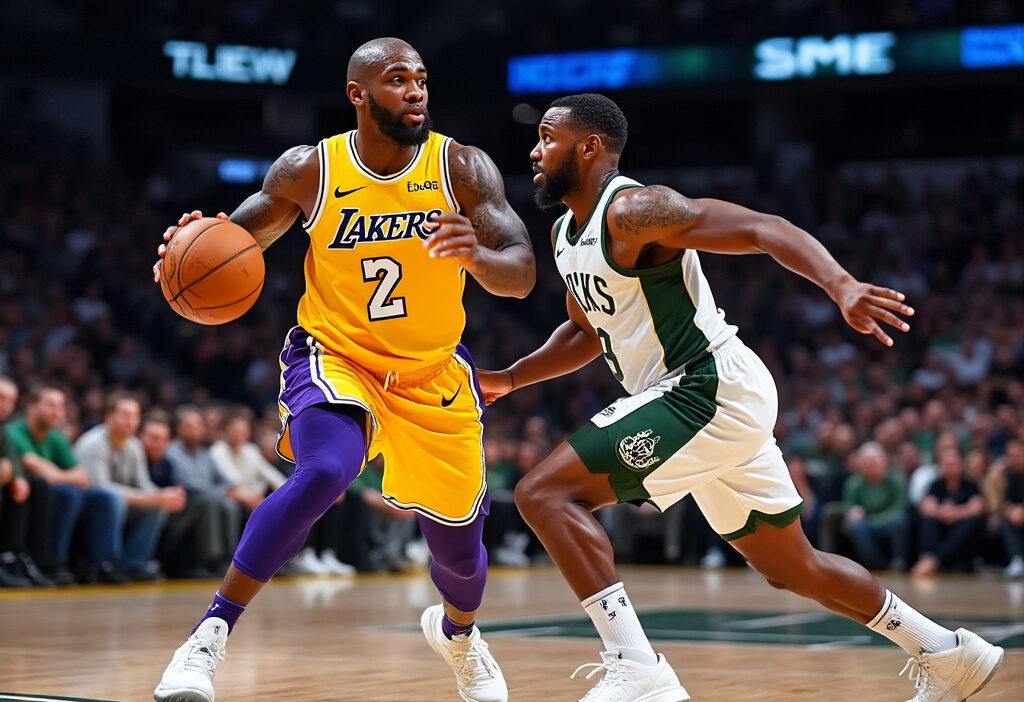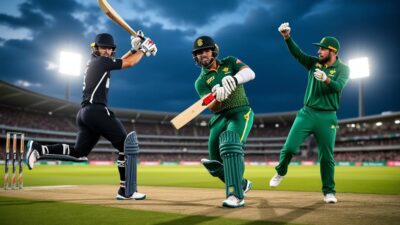Lakers vs Milwaukee Bucks A Historic Rivalry on the Court
The Los Angeles Lakers and the Milwaukee Bucks have a storied history in the NBA, marked by thrilling games, legendary players, and unforgettable moments. This article delves into the rivalry, key matchups, and the impact these teams have had on basketball history. From iconic players to championship battles, we explore what makes this rivalry so special.
The Origins of the Rivalry
The rivalry between the Los Angeles Lakers and the Milwaukee Bucks began to take shape in the early 1970s, a period when both franchises were at the pinnacle of the NBA. The Bucks, led by the towering presence of Kareem Abdul-Jabbar and the savvy playmaking of Oscar Robertson, quickly rose to prominence after joining the league in 1968. By 1971, they had already secured an NBA championship, showcasing their dominance. Meanwhile, the Lakers, with stars like Jerry West and Wilt Chamberlain, were perennial contenders in the Western Conference, setting the stage for epic clashes between the two teams.
The rivalry intensified when Kareem, then known as Lew Alcindor, was traded to the Lakers in 1975. This move not only shifted the balance of power in the NBA but also added a personal layer to the rivalry, as Kareem faced his former team. The matchups during this era were defined by their physicality and strategic depth, with both teams vying for supremacy. The 1972 NBA Finals, where the Lakers triumphed over the Bucks in a hard-fought series, remains a cornerstone of their early encounters. These battles laid the foundation for a rivalry that would evolve over decades, fueled by the legacies of the players who defined this era.
Iconic Players and Their Impact
The Lakers vs. Bucks rivalry was elevated to legendary status by the contributions of iconic players who not only defined their teams but also left an indelible mark on the NBA. Kareem Abdul-Jabbar, a towering figure in basketball history, played a pivotal role in shaping this rivalry. After leading the Bucks to their first NBA championship in 1971, Kareem’s move to the Lakers in 1975 added a personal layer to the competition, as he faced his former team with a new sense of purpose. His skyhook became a symbol of dominance, and his leadership helped the Lakers transition into the “Showtime” era.
Magic Johnson, the maestro of the Lakers’ fast-paced offense, brought a new dimension to the rivalry in the 1980s. His ability to orchestrate plays and elevate his teammates turned the Lakers into a powerhouse, creating a stark contrast to the Bucks’ gritty, defensive style. Meanwhile, Oscar Robertson, the “Big O,” was instrumental in the Bucks’ early success. His versatility and basketball IQ complemented Kareem’s dominance, making the Bucks a formidable opponent.
These players didn’t just compete; they redefined the game. Their individual brilliance and team-first mentality set the standard for future generations, ensuring that the Lakers-Bucks rivalry remains a cornerstone of NBA history.
Championship Showdowns
The championship showdowns between the Los Angeles Lakers and Milwaukee Bucks are etched in NBA history, with the 1971 and 1980 NBA Finals standing out as defining moments. In 1971, the Bucks, led by Kareem Abdul-Jabbar and Oscar Robertson, faced a Lakers team anchored by Jerry West and Wilt Chamberlain. The Bucks dominated the series, showcasing a blend of Abdul-Jabbar’s skyhook and Robertson’s playmaking. Their suffocating defense and fast-paced offense overwhelmed the Lakers, culminating in a 4-0 sweep and Milwaukee’s first NBA title. This victory solidified the Bucks as a powerhouse and marked the beginning of Abdul-Jabbar’s legacy.
The 1980 Finals reignited the rivalry, but with a twist: Abdul-Jabbar, now a Laker, faced his former team. Despite his absence in Game 6 due to injury, rookie Magic Johnson stepped up, playing center and delivering a historic 42-point, 15-rebound, 7-assist performance. The Lakers’ “Showtime” offense, orchestrated by Johnson, outmaneuvered the Bucks’ gritty defense. The series ended 4-2, with the Lakers claiming their seventh title. These battles not only highlighted the teams’ contrasting styles but also underscored the evolution of basketball strategy, from the Bucks’ disciplined approach in 1971 to the Lakers’ fast-break brilliance in 1980.
The Modern Era
The modern era of the Lakers vs Bucks rivalry has been defined by the rise of two generational talents: LeBron James and Giannis Antetokounmpo. Since LeBron joined the Lakers in 2018 and Giannis emerged as the Bucks’ cornerstone, their matchups have become must-watch events, blending individual brilliance with team dynamics. The rivalry has shifted from the championship-driven clashes of the past to a battle of contrasting styles. The Lakers, with their emphasis on veteran leadership and LeBron’s playmaking, often rely on a slower, methodical approach. In contrast, the Bucks, led by Giannis’ relentless athleticism and transition dominance, embody the modern NBA’s pace-and-space philosophy.
Key matchups in recent years have highlighted these differences. The 2020 regular-season game, where the Bucks defeated the Lakers, showcased Giannis’ dominance with 34 points and 11 rebounds, while LeBron countered with 21 points and 12 assists. These games often serve as a litmus test for championship aspirations, with both teams adjusting their strategies to counter each other’s strengths. The evolution of three-point shooting, defensive schemes, and positionless basketball has further intensified the rivalry, making it a microcosm of the NBA’s tactical evolution in the 21st century.
Key Games and Memorable Moments
The Lakers vs Bucks rivalry has produced some of the most electrifying moments in NBA history, with key games and unforgettable plays etching themselves into basketball lore. One of the most iconic matchups occurred on December 19, 1971, when the Bucks, led by Kareem Abdul-Jabbar and Oscar Robertson, faced off against the Lakers, featuring Jerry West and Wilt Chamberlain. The game ended in a thrilling 120-118 victory for Milwaukee, with Kareem hitting a game-winning skyhook that solidified his dominance. Fast forward to March 6, 2020, when the Bucks and Lakers clashed in a battle of titans. Giannis Antetokounmpo and LeBron James went head-to-head, with the Lakers securing a 113-103 win. LeBron’s clutch three-pointer late in the fourth quarter and Anthony Davis’ defensive stops were pivotal moments that showcased the intensity of the modern rivalry. Another unforgettable game was the 1972 NBA Finals, where the Lakers defeated the Bucks in six games, with Wilt Chamberlain’s defensive prowess and Gail Goodrich’s scoring leading the charge. These moments, among others, have defined the Lakers-Bucks rivalry, blending historic plays with modern-day brilliance.
Statistical Comparisons
The Lakers and Bucks rivalry is not only defined by iconic moments but also by compelling statistical comparisons that highlight their competitive balance. Historically, the Lakers hold a slight edge in head-to-head matchups, with a regular-season record of 94-84 as of 2023. However, the Bucks have closed the gap in recent years, fueled by Giannis Antetokounmpo’s dominance. In playoff encounters, the Lakers have been more successful, winning 3 of their 4 postseason series, including the 1971 NBA Finals, where Milwaukee’s lone championship against Los Angeles remains a defining moment.
Individually, the rivalry has showcased legends like Kareem Abdul-Jabbar, who played pivotal roles for both teams. Kareem’s 38,387 career points remain unmatched, while Magic Johnson’s triple-doubles and Oscar Robertson’s all-around brilliance further enriched the narrative. In the modern era, LeBron James and Giannis have elevated the rivalry, with Giannis averaging 28.7 points and 12.1 rebounds against the Lakers, compared to LeBron’s 27.3 points and 8.1 assists in their matchups.
Statistically, the Bucks have excelled in defensive metrics, often ranking among the league’s best in opponent field goal percentage, while the Lakers have leaned on their offensive firepower, consistently ranking high in points per game. These numbers underscore a clash of styles, with Milwaukee’s grit contrasting Los Angeles’ finesse, making their battles a fascinating study in basketball strategy.
Fan Perspectives and Cultural Impact
The Lakers vs Bucks rivalry transcends statistics and on-court battles, deeply resonating with fans and shaping basketball culture. For Lakers fans, the Bucks represent a formidable Eastern Conference adversary, a team that has historically challenged their dominance. The purple and gold faithful often view Milwaukee as a litmus test for their team’s championship aspirations, especially during eras when both franchises boasted superstars like Kareem Abdul-Jabbar, Magic Johnson, and LeBron James for the Lakers, and Oscar Robertson, Giannis Antetokounmpo, and Kareem (during his Bucks tenure) for Milwaukee. Bucks fans, on the other hand, see the Lakers as a symbol of West Coast glamour and media favoritism, fueling a sense of underdog pride.
Culturally, the rivalry has amplified the NBA’s global appeal. Media coverage often frames their matchups as clashes of contrasting styles—showtime vs. grit, Hollywood vs. the Heartland. Fan traditions, like the Lakers’ “Beat L.A.” chants in Milwaukee or the Staples Center’s electric atmosphere during Bucks visits, highlight the passion this rivalry ignites. Social media further amplifies these interactions, with debates over Giannis’ dominance versus LeBron’s legacy becoming viral moments. This rivalry isn’t just about wins and losses; it’s a cultural phenomenon that unites and divides basketball fans worldwide.
Coaching Strategies
The coaching strategies employed by the Lakers and Bucks have been pivotal in shaping their historic rivalry. Phil Jackson, the mastermind behind the Lakers’ dominance in the early 2000s, utilized the Triangle Offense to perfection, creating a system that maximized the talents of Kobe Bryant and Shaquille O’Neal. Jackson’s emphasis on team chemistry and mental toughness often gave the Lakers an edge in high-pressure matchups against the Bucks. His ability to adapt in-game strategies, particularly in playoff scenarios, cemented his legacy as one of the greatest coaches in NBA history.
On the other side, Mike Budenholzer brought a modern approach to the Bucks, emphasizing three-point shooting and defensive versatility. His system, built around Giannis Antetokounmpo’s unique skill set, transformed Milwaukee into a championship contender. Budenholzer’s focus on pace and space basketball forced opponents, including the Lakers, to adjust their defensive schemes. His strategic use of timeouts and adjustments during games often turned the tide in Bucks’ favor.
The contrasting styles of these coaches—Jackson’s old-school finesse versus Budenholzer’s analytical precision—have added layers of intrigue to the Lakers-Bucks rivalry, making each matchup a chess match on the hardwood.
The Role of Home Court Advantage
Home court advantage has played a pivotal role in shaping the Lakers vs Bucks rivalry, often tipping the scales in tightly contested matchups. The Staples Center, now Crypto.com Arena, has been a fortress for the Lakers, with its roaring crowd and familiar surroundings providing a psychological edge. Similarly, the Bucks have thrived at Fiserv Forum, where their passionate fanbase creates an intimidating atmosphere for visiting teams. Historically, both teams have leveraged their home courts to amplify their strengths—whether it’s the Lakers’ fast-paced transition game or the Bucks’ defensive intensity anchored by Giannis Antetokounmpo.
Key games highlight this dynamic. For instance, during the 2020 regular season, the Bucks secured a dominant win at home, fueled by Giannis’ 34-point performance, only for the Lakers to retaliate at Crypto.com Arena with LeBron James orchestrating a masterclass. The energy of the home crowd often elevates star players, as seen in Kareem Abdul-Jabbar’s iconic performances for the Bucks in the 1970s and Magic Johnson’s showtime brilliance in Los Angeles. Home court advantage isn’t just about comfort—it’s about momentum, confidence, and the ability to dictate the game’s tempo, making it a critical factor in this storied rivalry.
Future of the Rivalry
The future of the Lakers vs Bucks rivalry promises to be as electrifying as its storied past, with both franchises poised to remain at the forefront of the NBA. As the league evolves, so too will the dynamics of this clash, fueled by emerging stars and strategic roster moves. Giannis Antetokounmpo and Anthony Davis are likely to remain the cornerstones of their respective teams, but the rise of younger talents like Austin Reaves for the Lakers and MarJon Beauchamp for the Bucks could inject fresh energy into the rivalry. The potential for blockbuster trades or free-agent signings could further shift the balance of power, ensuring that each matchup carries high stakes.
With the NBA’s global reach expanding, the Lakers-Bucks games will continue to draw massive audiences, amplifying the intensity on the court. The rivalry’s evolution may also be shaped by coaching strategies, as both teams adapt to new trends in the game, such as increased emphasis on three-point shooting and positionless basketball. As the league’s landscape shifts, the Lakers and Bucks will likely remain perennial contenders, setting the stage for epic battles in the playoffs and beyond. The future of this rivalry is not just about the players but also about the legacy they build, ensuring that every chapter adds to the rich history of these two powerhouse franchises.

Conclusions
The Lakers vs Bucks rivalry is a testament to the rich history and competitive spirit of the NBA. From legendary players to unforgettable games, this rivalry has captivated fans for decades. As both teams continue to evolve, the future promises even more thrilling encounters. Whether you’re a Lakers fan or a Bucks supporter, this rivalry is a cornerstone of basketball history.



